33 Peruvian Foods: Traditional Food in Peru (Dishes, Drinks, Desserts)
What’s the best food to try in Peru? Well, I asked over 1,000 locals and expats what their favorite traditional dish was. The following 33 Peruvian food favorites rose to the top. From main dishes to desserts and drinks, brace yourself for the mouth-watering answers below.
33 Traditional Foods to Try in Peru
Machu Picchu, Lima, the Andes Mountains, Lake Titicaca, and the Amazon Jungle are all fantastic reasons to visit Peru. But what about all the delicious food? Some unforgettable gastronomy awaits you.
And did you know that Peru is to thank for some pretty important contributions to everyday food favorites around the world?
For example, what country comes to your mind when I say “potato”? For me, Ireland came to mind. But did you know that the humble potato most likely originated in Peru? In fact, Peru has between 3,500-4,000 different varieties of potatoes. History would suggest that the tomato also started its journey in Peru.
So what can you expect from Peruvian cuisine? A variety! From yummy ‘comfort food’ to more exotic dishes, Peru has something for everyone.
27 Main Dishes to Try in Peru
Whether you’re a meat and potatoes kind of person, a lover of vegetables, a seafood fan, or all of the above – you’ll find something delicious among these traditional Peruvian main dishes.
Let’s start off with a meat and potato option.
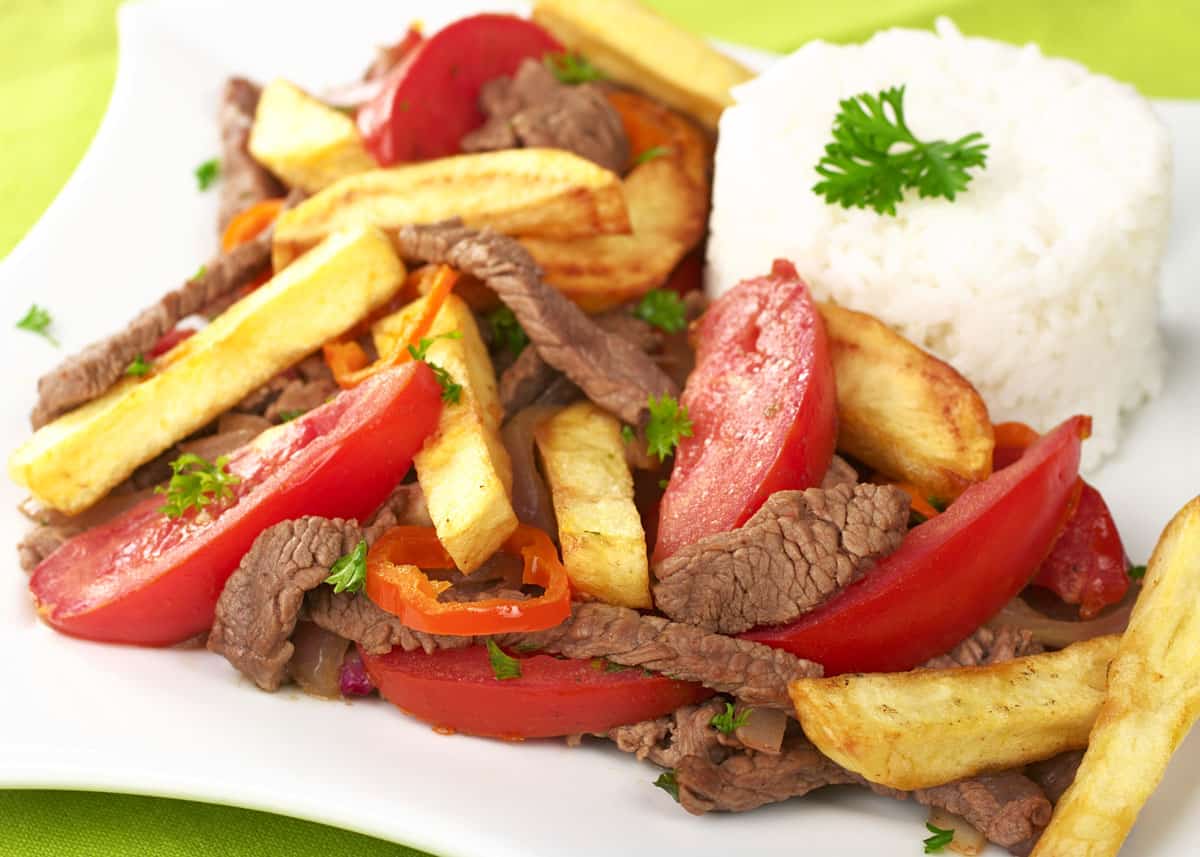
1. Lomo Saltado
Looking for a new way to enjoy French Fries? Then look no further than lomo saltado. This Peruvian stir-fry combines marinated strips of sirloin, tomatoes, onions, and french fries. Typically accompanied by rice.
2. Crema de Zapallo
Perfect on a cool day, crema de zapallo is a pureed squash soup flavored with onions, garlic, and vegetable stock. Pureed carrots or sweet potatoes may also be added.
3. Locro (de Zapallo)
More of a stew than a soup, everyone loves Peruvian locro. Made with diced pumpkin, squash, potatoes, corn, broad beans, and chunks of fresh white cheese – this hearty meal is sure to fill you up. Served with white rice.
4. Parihuela
Found all along the coast, parihuela is a spicy seafood soup.
The beauty of this soup is found in the freshness of the seafood. Straight from the ocean to your stomach (plus preparation time of course).
It’s usually made with white fish (like bass or cod) and the spiciness comes from the hot pepper aji panca .
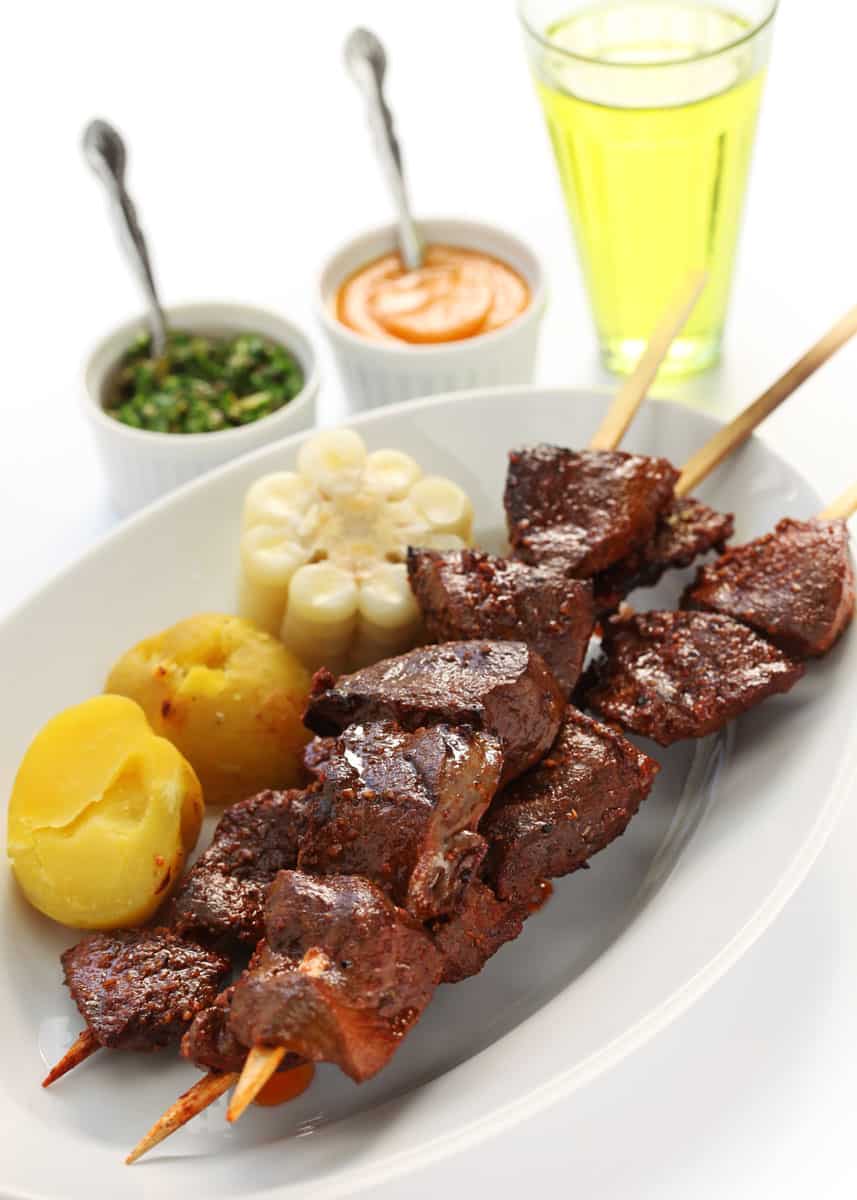
5. Anticuchos
Delicious and cheap, anticuchos are a popular food sold by street vendors. Like a kebab in other parts of the world, anticuchos are skewers of marinated and grilled meat.
Although you can find them made with steak or sometimes chicken, the most common kind is made with beef heart (anticuchos de corazon).
6. Ocopa
Ocopa is the name of a sauce in Peru. It’s made with ají amarillo (yellow chili pepper), onions, garlic, cheese, ground crackers, and evaporated milk (among other ingredients). It is similar to the sauce used on papa a la huancaina, but with added peanuts and huacatay (a herb common to South America, also called black mint).
Ocopa can be served cold on hard-boiled eggs, or hot on boiled potatoes. Why not try both?
7. Papa a la Huancaina
Mentioned above, this dish consists of sliced boiled yellow potatoes covered in a spicy creamy sauce. The sauce may be slightly lumpy if made with a traditional mortar, or silky smooth if made in an electric blender.
This is commonly served with a side of boiled eggs and black olives.
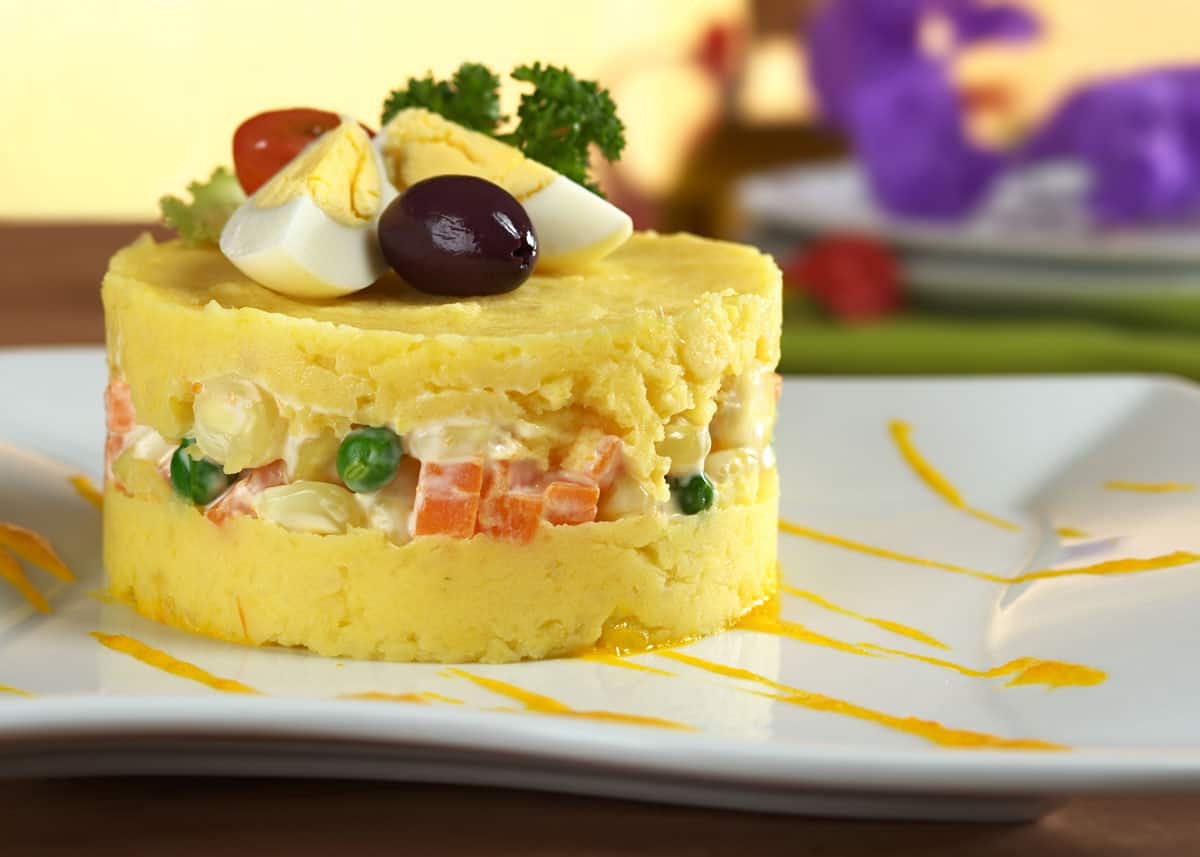
8. Causa Rellena
This multi-tiered appetizer or side dish alternates layers of mashed potatoes (flavored with ají amarillo and lime juice) with layers of yummy fillings. Fillings may include tuna salad, chicken, or avocado.
It’s served cold and is a feast for the eyes and the stomach!
9. Papas Rellenas
Mashed potatoes, shaped into a ball, stuffed with goodness, and fried in oil until golden brown – what’s not to love?
While many countries have their own version of papas rellenas, the ones in Peru are usually stuffed with ground beef, olives, raisins, and chopped hard-boiled eggs.
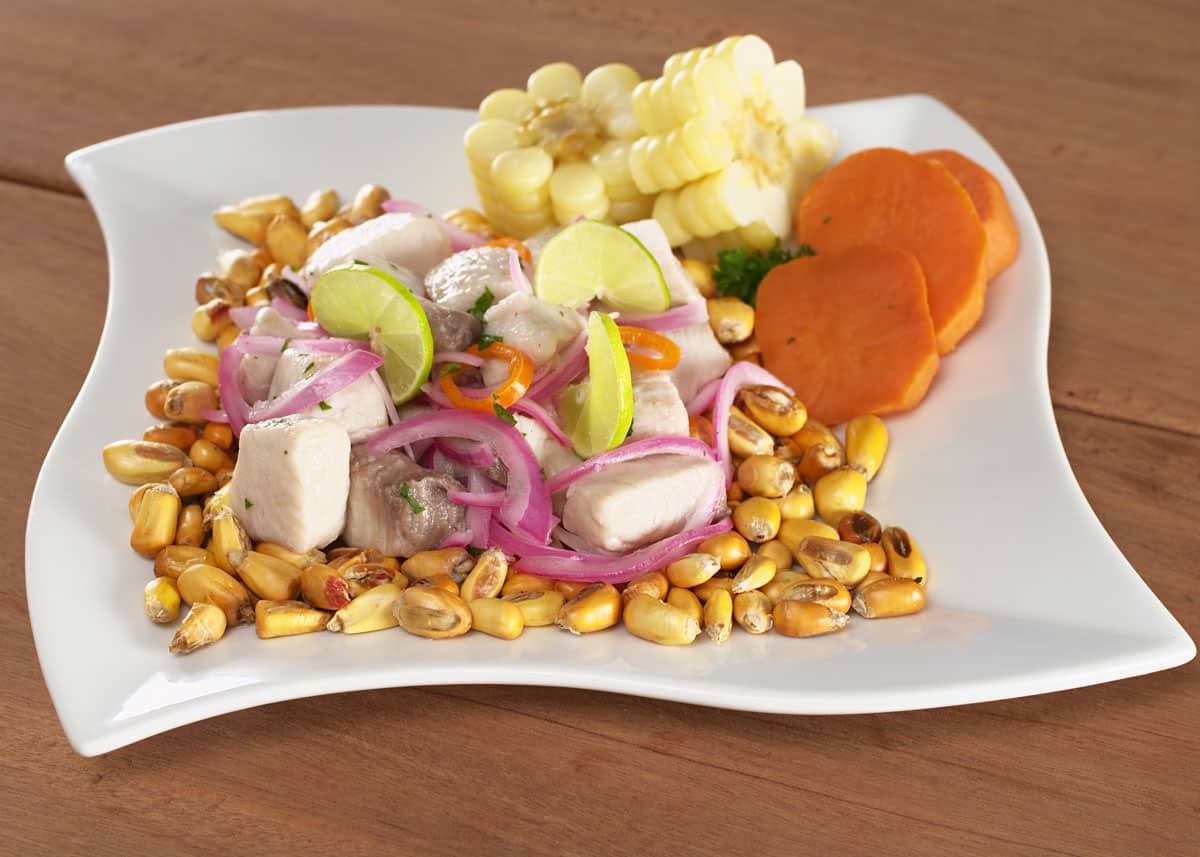
10. Ceviche
Served in restaurants around the world, we have Peru to thank for inventing this delicious recipe. Fresh raw fish is cured in lemon or lime juice. Chile peppers, red onions, and cilantro round out the dish.
Is it safe to eat? Well, when you use heat to cook food, this causes changes to the chemical properties of a food and kills bacteria. The acidity in the citrus accomplishes the same thing. So unless you are allergic to seafood, eat up.
11. Chocho
Chocho or tarwi (Lupinus mutabilis) are small cream-colored beans grown in the high valleys of the Andes. They can be found in a variety of popular dishes. There’s even a ceviche de tarwi which is popular in northern Peru.
If purchasing raw, make sure to soak them for a few days before cooking. This will make them less bitter and easier to digest.
12. Lentejas
Lentejas are lentils and can be used in a variety of ways, including in a wonderful lentil soup. Just add onion, tomato, garlic, and beef stock.
You’ll also find them in many of the side dishes served in Peru, and the popular dish Tacu Tacu (more on that below).
13. Escabeche de Pollo
Simply translated, this means marinated chicken. Marinated in what you may ask? Vinegar, red onions, and a variety of herbs and spices.
This same base can also be used to marinate fish, giving it both a savory and tangy taste.
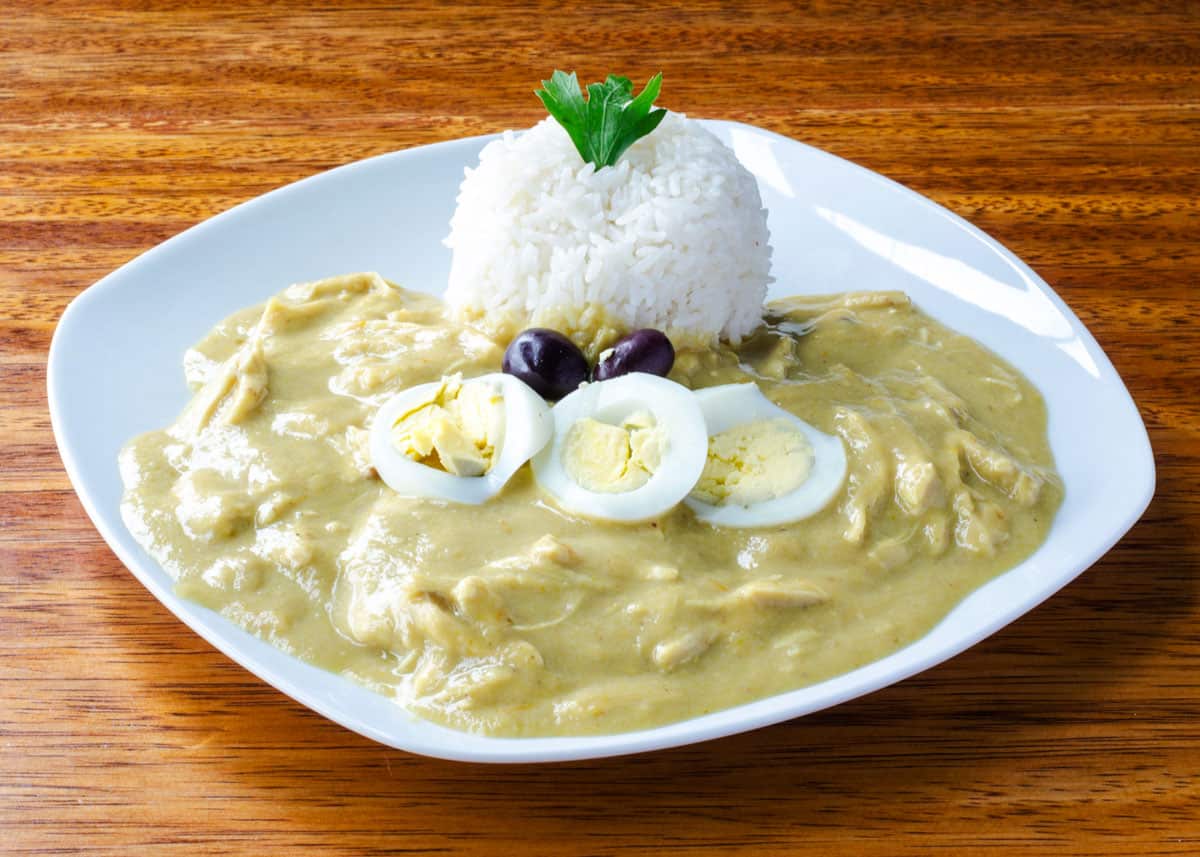
14. Aji de Gallina
Loved throughout Peru as typical comfort food, this chicken stew is a must-try. The creamy sauce is made with the ají amarillo pepper, bread soaked in milk, ground nuts (either pecans or walnuts), and shredded chicken.
Traditionally served with either rice or potatoes, black olives, and a boiled egg.
15. Seco de Res or Seco de Pollo
Seco means dry. As a cooking method, it means reducing the amount of liquid over low heat until you get a thick stew.
The ingredients in seco will vary depending on what part of the country you are in. It can be made with beef (res) or with chicken (pollo). Or if you are in Lima, you might get it made with seafood.
Common ingredients may include ají amarillo peppers, peppercorn, cumin, and cilantro.
Seco is also a popular dish in neighboring Ecuador.
16. Tacu Tacu
Originating as a way to use up leftovers, tacu tacu is Peru’s version of beans and rice.
Fried together in a skillet, tacu tacu is served as a large patty. Eaten as a side dish for breakfast (with a fried egg), lunch, or supper.
If you like this, you might enjoy “gallo pinto” a popular dish in Nicaragua.
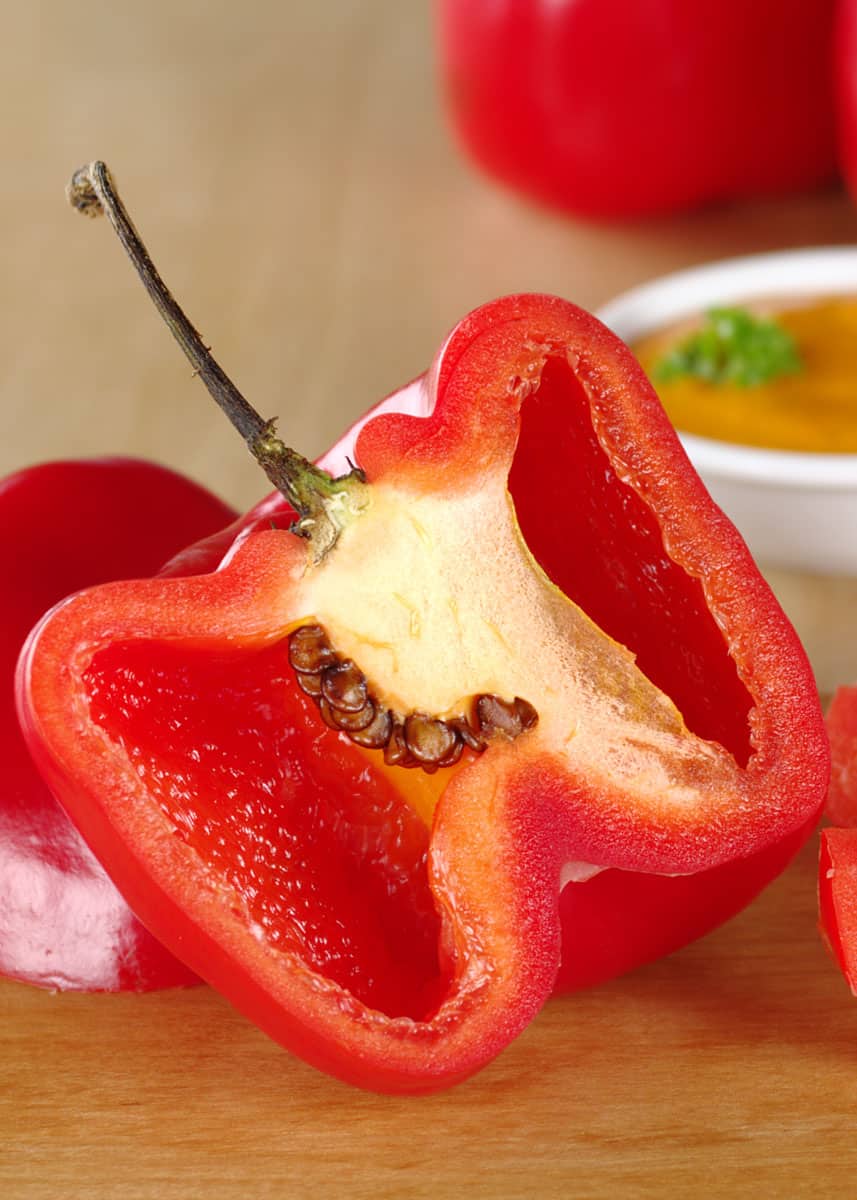
17. Rocoto Relleno
Now comes something hot and spicy. Rocoto relleno is from the Arequipa region in the Andes.
Rocoto is a type of Peruvian pepper. Although it looks like a sweet red bell, don’t be fooled by its appearance. When raw, rocoto peppers are said to be ten times hotter than a jalapeño. But the cooking process does lessen the intensity of the heat.
Relleno means stuffed. In this case, stuffed with a yummy, creamy ground beef mixture.
18. Sudado de Pescado
Healthy and easy to make, sudado de pescado is steamed fish. Flavored with garlic, onions, tomatoes, and the well-loved ají amarillo pepper.
19. Carapulcra
This stew has been made for centuries by both the Quechua and Aymara indigenous peoples.
In former times, alpaca or llama was the meat of choice. Today it is more commonly made with pork, along with potatoes and peanuts.
20. Chanfainita con Tallarin
An unfortunate part of the history of many countries was the importing of slaves from Africa. Peru was not exempt from this. But as a result of the influx of culture, new recipes were created. Chanfainita was one of these dishes. It’s a sauce containing cow lung and potatoes.
Today you may find chanfainita served with tallarin (noodles). Think of it as Peruvian spaghetti and meat sauce.
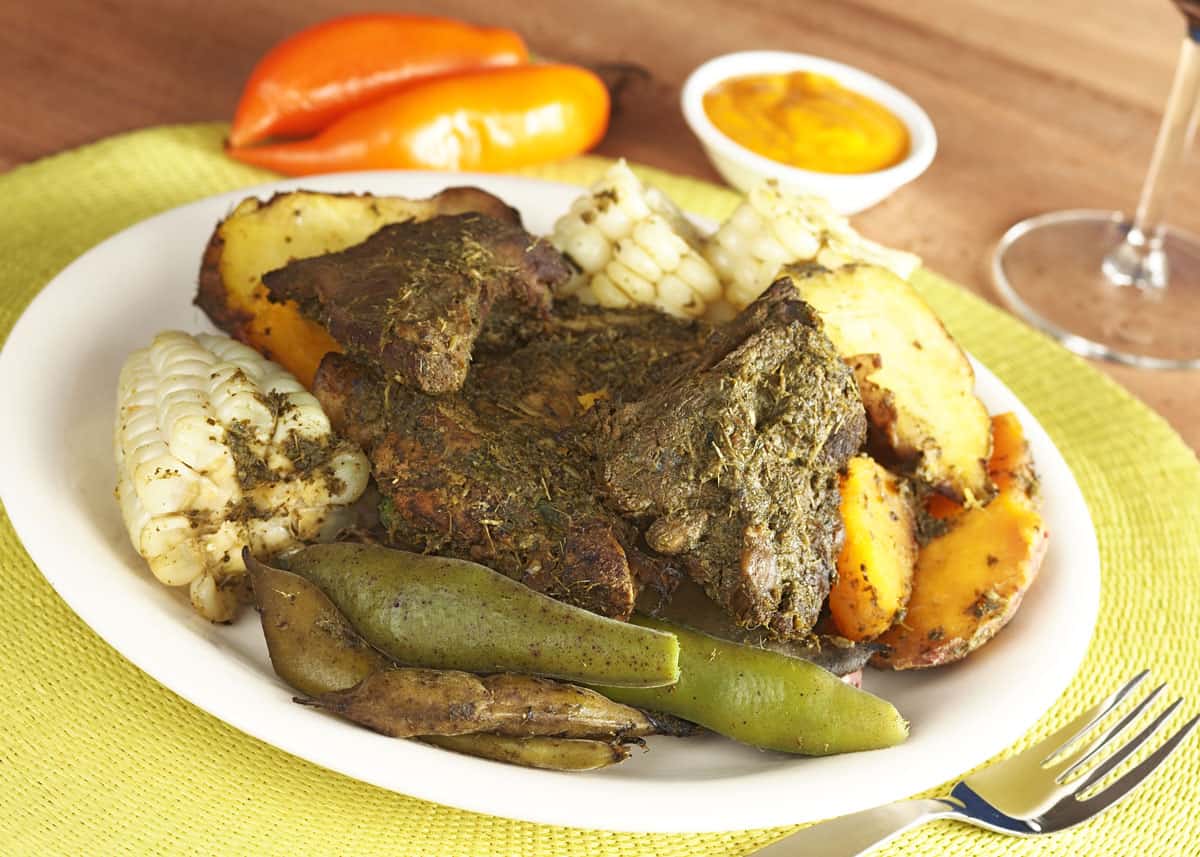
21. Pachamanca
Pachamanca is from the Quechua language, and literally means “earth pot” or “earth oven.” Interestingly, Pachamama is the name of an Incan goddess, compared to “Mother Earth” in other cultures. There may be a ceremony preformed as it is prepared.
A hole is dug into the earth and lined with bricks. Volcanic rocks are heated with fire and then placed at the bottom of the pit. Sweet potatoes, meat, corn (and whatever else you want to cook) are placed in order of cooking time onto the stones. The pit is then sealed.
The result is succulent, fall-off-the-bones meat, and tender steamed vegetables with a hint of smoke.
Pachamanca is a great way to feed a large crowd or party.
22. Tacacho
A typical breakfast food, tacacho combines cooked mashed plantains, lard, pork rind, and salt (all rolled into a ball). Served with chorizo sausage, and salad.
23. Pulpo al Olivo
If you like the sound of octopus in olive sauce, this dish is for you. The cooked octopus is covered in a thick mayonnaise sauce which is made by combining eggs, black olives, olive oil, lemon juice, and pepper. The dish is often garnished with chopped parsley.
Pulpo al olivo is usually served with potatoes.
24. Tiradito
Tiradito is a dish of raw slices of fish, drizzled with a mixture of lime juice, chili peppers, and grated ginger.
It is similar to sashimi and influenced by Japanese immigrants. Peru actually has a very large Japanese population dating back to the late 1800s.
Unlike ceviche (which has time to cure in the juice), tiradito is truly raw (as the juice is poured on right before eating). This being the case, make sure you go to a reputable vendor, who can ensure the quality of the fish.
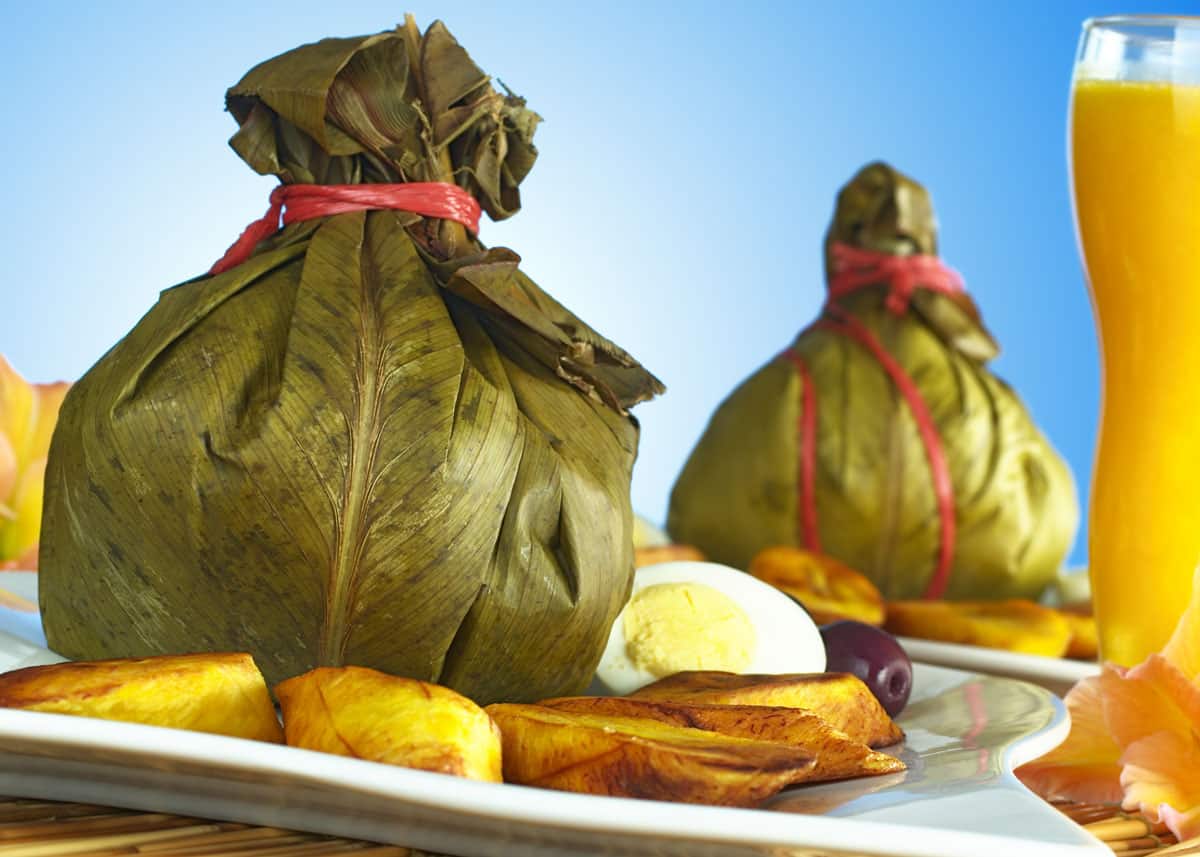
25. Juanes
Juan is Spanish for John. According to Catholic teachings, John the Baptist is the Patron Saint of the Amazon. So on June 24, in celebration of John, many Peruvians eat Juanes.
It consists of rice, meat (usually chicken), olives, hard-boiled eggs, and spices. These ingredients are wrapped up in bijao leaves and boiled for about an hour and a half.
26. Charqui
Charqui is Peruvian Jerky. Thin strips of meat are cured in salt and hung to dry over a period of weeks. Nowadays, most charqui is made with beef, but llama and alpaca can also be used.
27. Cuy
Simply put, cuy is guinea pig. A delicacy in Peru, especially in Cusco, my husband could not leave the country without trying it. It’s slightly gamier and richer in taste than chicken. But be prepared, the head may still be attached, teeth and all.
Should you want to try it, know that cuy al horno is roasted guinea pig, while cuy chactado is fried.
4 Peruvian Drinks
Some of the unique flavors of Peru come from a wide variety of Peruvian drinks. From Tiger’s Milk that does not come from a tiger to a popular soda created in Peru, you’ll find an almost endless list of drinks to choose from.
The following are some of the most popular and talked about options.
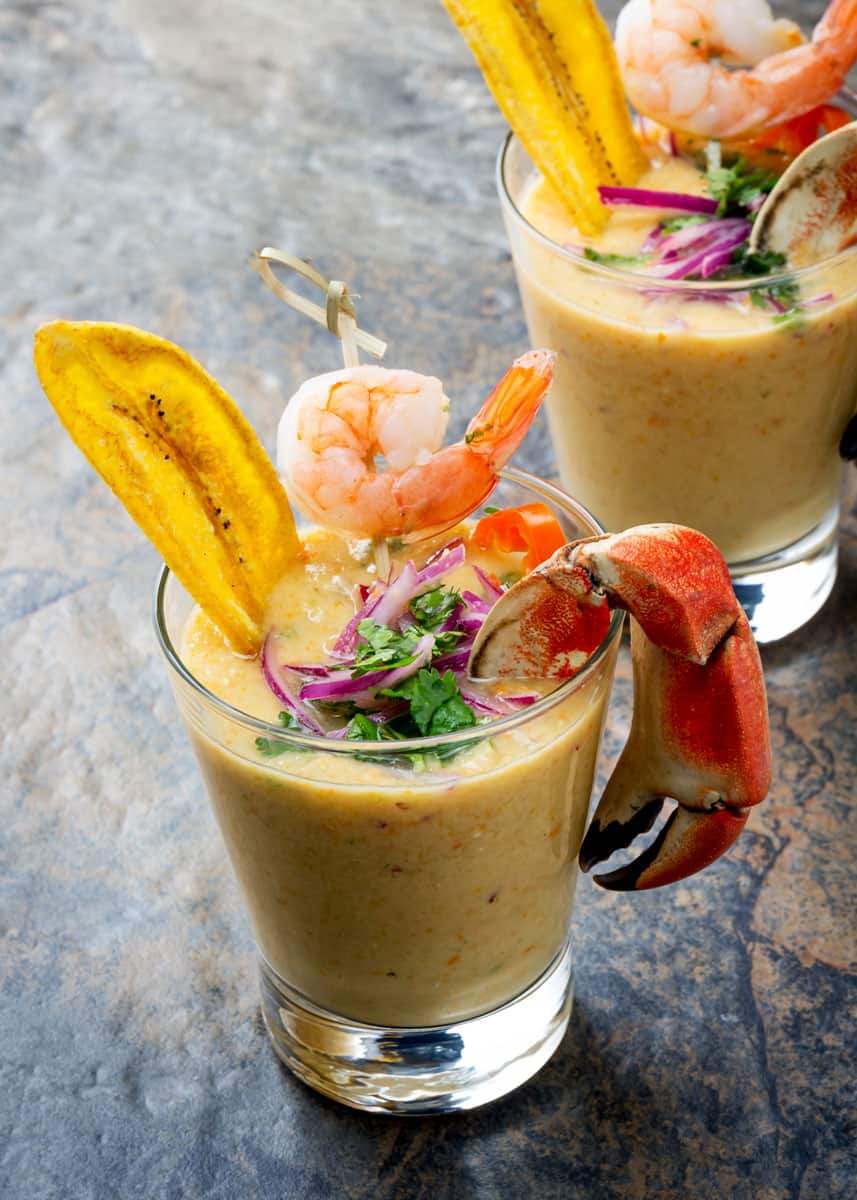
1. Leche de Tigre
Literally “tiger’s milk” this drink involves neither a tiger nor milk. It’s actually the lime-based mixture used on ceviche.
Some will drink it on its own, believing it to be a hangover cure, among other things.
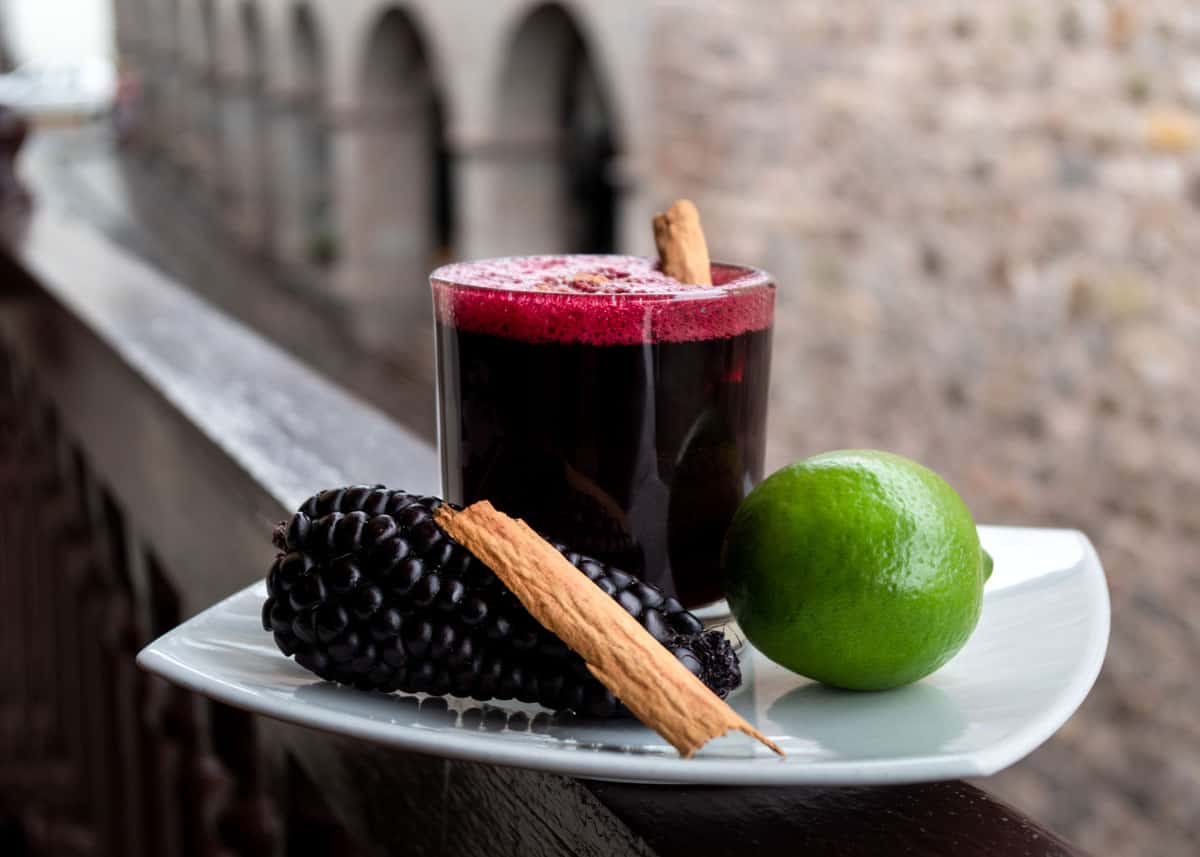
2. Chicha Morada
The base of this widely loved, nonalcoholic drink is made by boiling purple corn. After filtering the solids out; sugar, cinnamon, and cloves are added.
Some recipes call for the use of lime, apple, pineapple, or other juice. Served cold.
3. Inca Kola
Created in Peru in 1935, this soft drink is now found in stores around the world. Known for its yellow color, it’s taste has been compared to bubblegum or cream soda.
Although not listed on the bottle Inca Kola is said to contain lemon verbena (hierba luisa) a pleasant tasting herb with a slightly sweet lemon flavor. This herb is widely enjoyed in Peru as an herbal tea and used to flavor many popular drinks and dishes.
In the following video, you’ll see some cute kids trying Inca Kola for the first time.
4. Mate de Coca
This herbal tea is used as a cure for altitude sickness and other conditions. It contains alkaloids that, when extracted, serve as the base for cocaine. While the amount in an average cup of tea is relatively small, it may be enough to make you fail a drug test.
Also, unless it’s been “decocainized,” it is illegal in many countries. So be careful if you intend to bring some home as a souvenir.
More reading: Guide to the Best Bolivian Foods
2 Yummy Desserts in Peru
There are more than two desserts in Peru, but these ones were the most highly recommend.
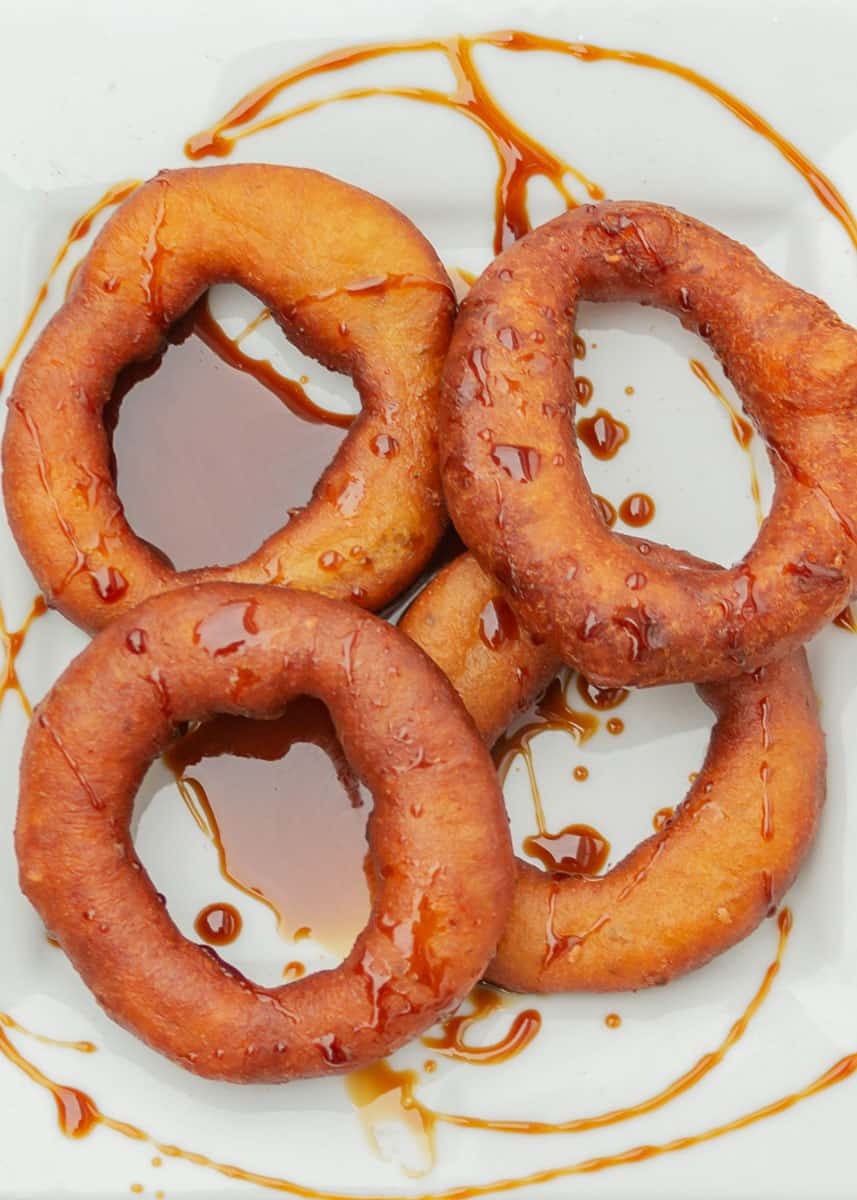
1. Picarones
Donuts! But instead of having a flour base, they are made from a dough of squash and sweet potato. Deep-fried and served with a sugary, thick syrup- yum!
The best place to get Picarones is straight from a street vendor, hot out of the oil.
2. Suspiro de Limeña
Light and airy, the name of this dessert actually means “The Sigh of a Lady from Lima.”
The base is made of dulce de leche (almost like a caramel pudding). The next layer is a meringue flavored with Port. Topped off with a sprinkle of cinnamon.
Learn more about Chilean food, located due south of Peru.
Your Turn:
What is your favorite Peruvian food? Or which one do you want to try most? Please add your thoughts to the comments below.

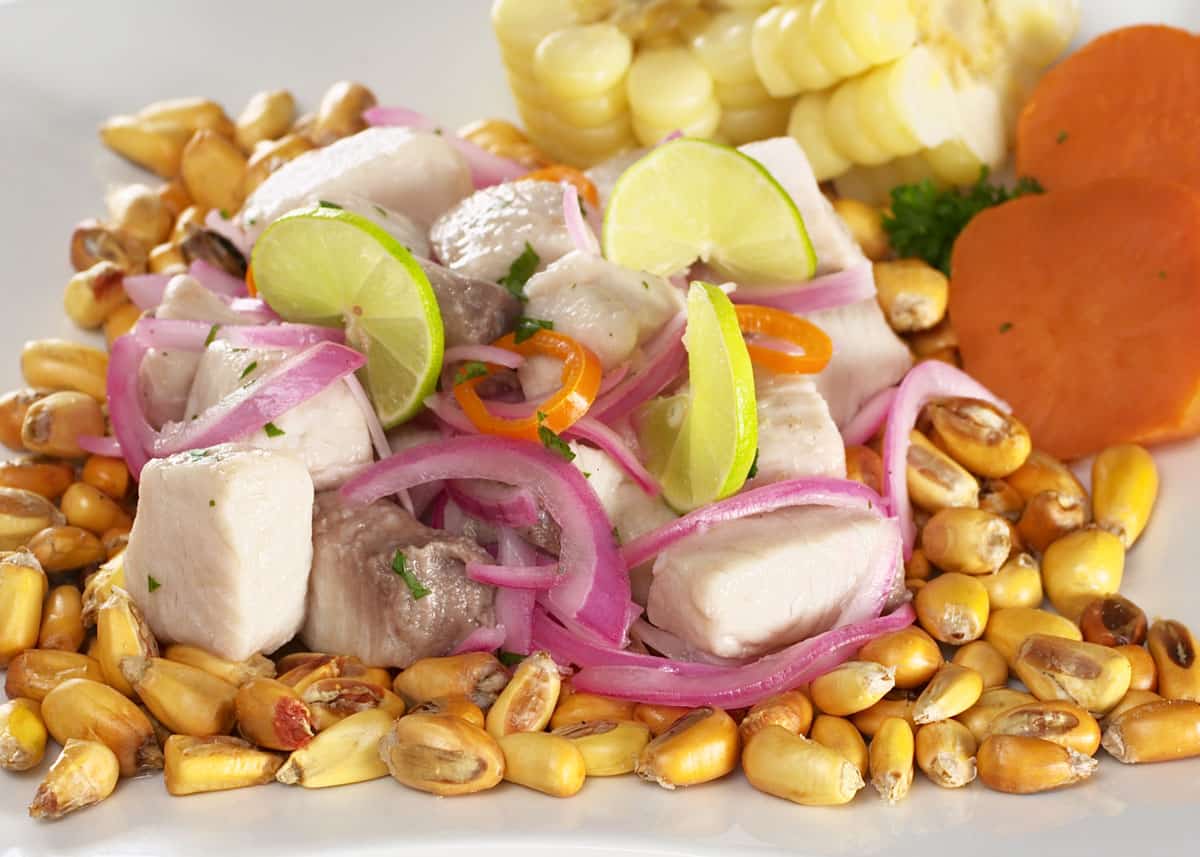
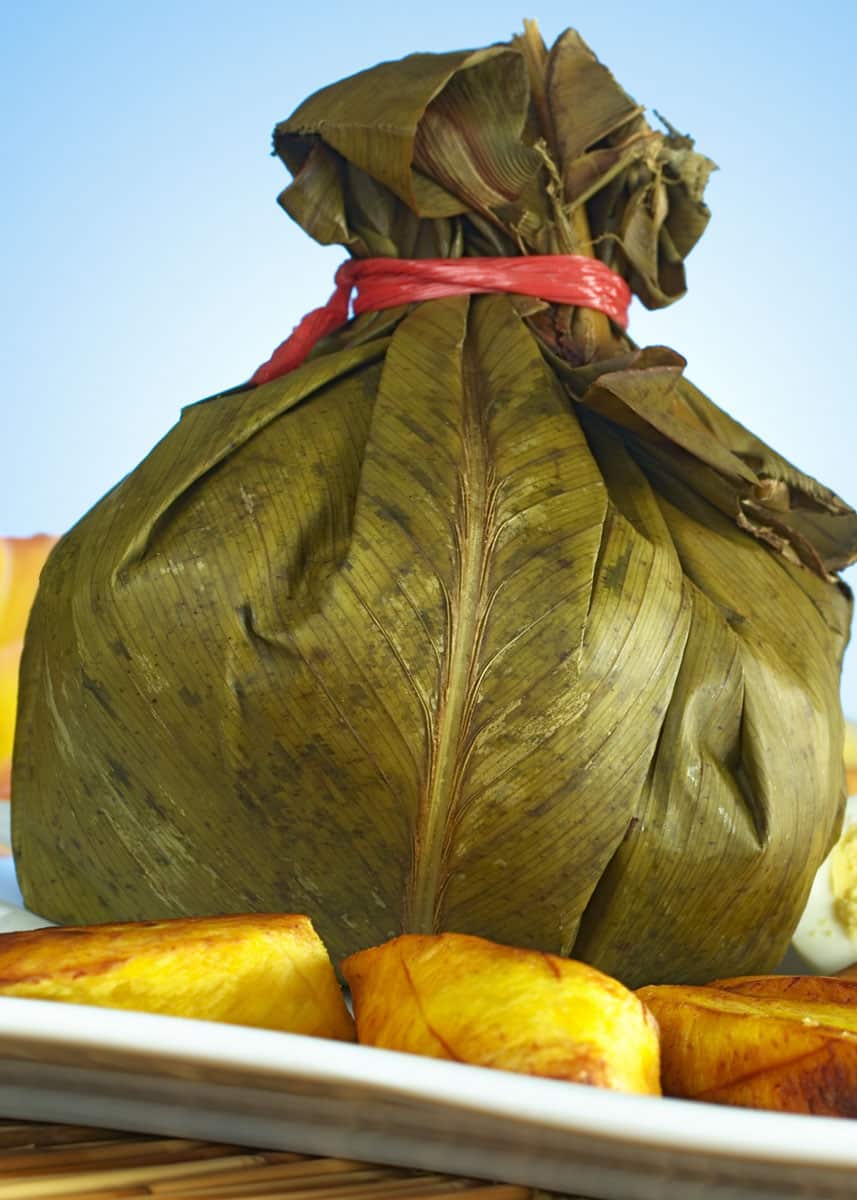
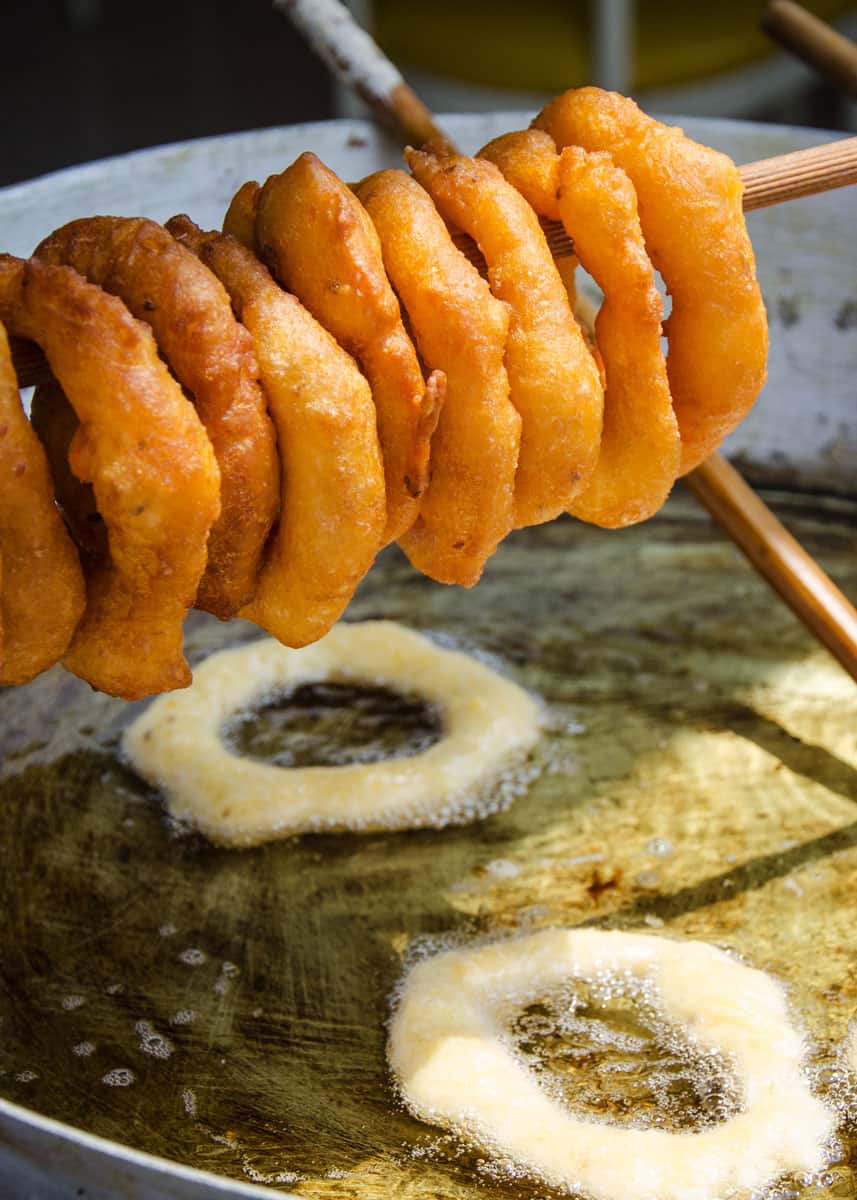


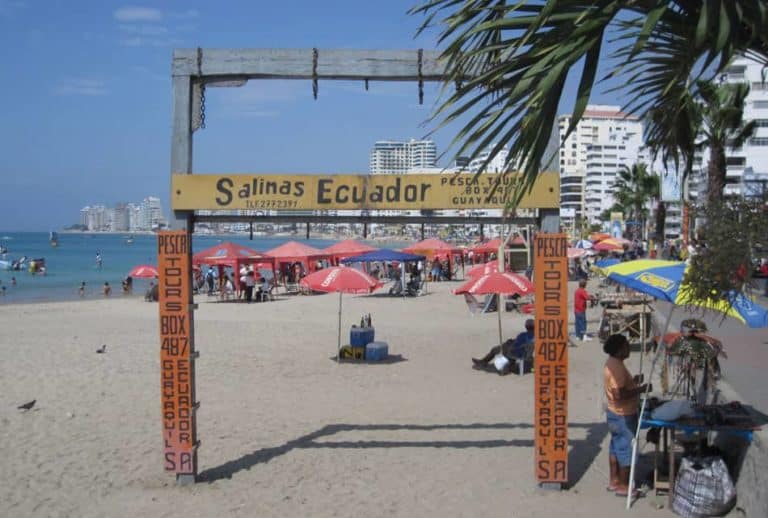
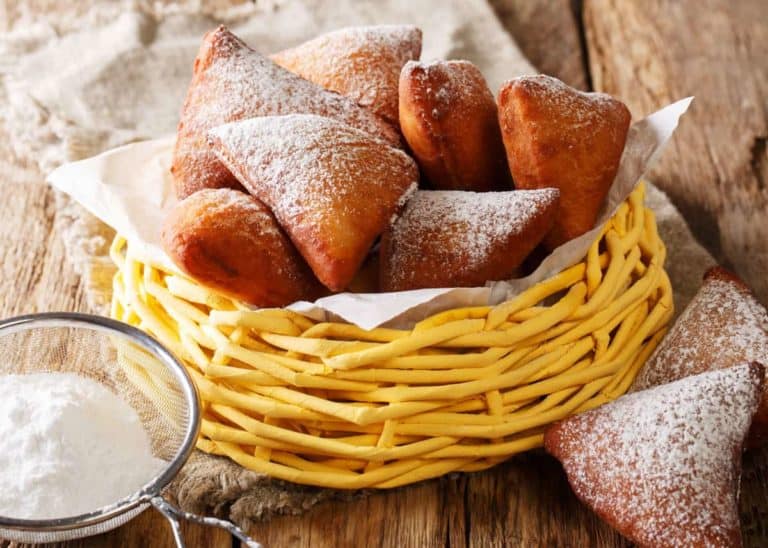


Diane I love your review, u got to try Cau-Cau and tallarin saltado, yumi!
Ahhh!!! PERU 🇵🇪!!!
Went in 2004!!! One of my favorite places that I’ve traveled to. EASILY !!! Remember sitting in a coffee shop in Cuzco, writing in a journal; “This place is having a cathartic effect on me”!!! (And, ultimately, it seeps in as Spiritually!!!)
GO…. you’ll never forget it!!!!!
SO BEAUTIFUL!!!!! Must return there!!!! MUST!!!!!
How could you forget youu forget Saltado de Pollo? My favorite…💕
Thanks Rey – nice addition!